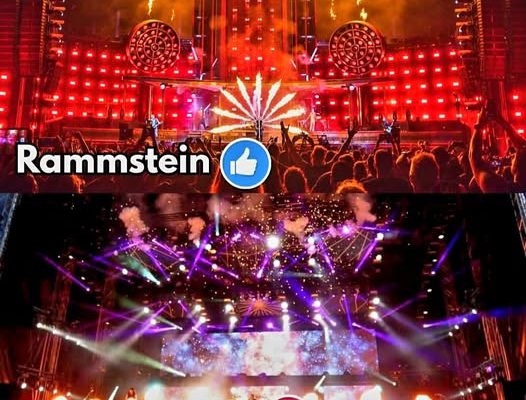When one speaks of heavy music’s global reach, the United States often comes to mind first, with its sprawling rock legacy and influence in shaping thrash, hardcore, and nu metal. Yet when we look toward Europe, a very different picture emerges—one of ambition, artistry, and sheer theatrical spectacle. Two bands, Rammstein and Nightwish, stand as titans of their respective subgenres, industrial metal and symphonic metal, and together they embody why Europe continues to hold an unshakable throne when it comes to creating music that blends fire with fantasy, brutality with beauty, and stagecraft with storytelling. Their careers are more than just about albums or tours; they are cultural statements, living proof that European artistry thrives on vision and reinvention, and they provide perhaps the clearest example of how a continent continues to define global standards in extreme and theatrical music.
Rammstein, born out of Berlin in the mid-1990s, emerged at a time when Germany was still redefining itself after reunification. Their music, built on pounding riffs, martial rhythms, and Till Lindemann’s baritone vocals, instantly captured attention for its unapologetic heaviness and provocative themes. But what truly propelled them beyond the underground was their ability to transform concerts into cinematic experiences. The term “industrial metal” may sound cold and mechanical, yet Rammstein took that aesthetic and injected it with fire—literally. Pyrotechnics are not an accessory to their shows; they are the language of their performance. Flames roar from the stage, engulf instruments, and even shoot from Lindemann’s mouth, blurring the line between danger and art. Every Rammstein performance feels like a ritual in which music, fire, and spectacle fuse into one overwhelming sensory storm. Their rise to global dominance is proof that Europe has mastered the art of scale—bringing opera-level ambition into the world of heavy guitars and mechanized beats.
Where Rammstein thrive on fire, Nightwish find their essence in fantasy. Hailing from Finland, they transformed the idea of what heavy metal could sound like by integrating symphonic arrangements, operatic vocals, and storytelling drawn from mythology, literature, and cinematic landscapes. Tuomas Holopainen, the band’s primary songwriter, has long envisioned Nightwish not as a traditional band but as a vessel for grand, orchestral tales that could move audiences as deeply as film scores or classical compositions. With singers such as Tarja Turunen, Anette Olzon, and now Floor Jansen bringing the band’s vision to life, Nightwish elevated metal into a realm of transcendence, where distorted guitars coexist with choirs and full orchestras. Their concerts are not simply rock shows; they are journeys into other worlds, complete with visuals, orchestrations, and the kind of emotional intensity that borders on the spiritual.
Placed side by side, Rammstein and Nightwish may seem like contrasts—one thrives on industrial darkness, the other on symphonic grandeur—but together they highlight Europe’s singular ability to innovate within metal by going beyond the music itself. American heavy metal often emphasizes technical proficiency or aggressive energy, but European bands frequently prioritize storytelling and atmosphere. Europe does not just produce musicians; it produces visionaries who see metal as an art form capable of carrying grand narratives. Rammstein and Nightwish embody two sides of the same European coin: one drenched in steel and fire, the other bathed in orchestral light and mythic resonance.
Rammstein’s dominance lies not only in their music but also in their ability to turn provocation into cultural conversation. Their lyrics, often controversial, touch on themes of politics, sexuality, and societal hypocrisy. In countries like Germany, where cultural memory carries heavy weight, Rammstein’s deliberate provocations have sparked debates that extend far beyond music magazines into political arenas and mainstream news. They challenge audiences to confront discomfort, to reckon with taboo subjects, and to think critically about the role of art in society. Yet despite, or perhaps because of, their polarizing nature, they command stadiums across the globe. Their success is not just in selling out arenas but in proving that European artists can balance mass appeal with uncompromising artistry, something few bands achieve with such consistency.
Nightwish, on the other hand, succeed not by provocation but by immersion. Their music creates worlds to escape into. For fans, listening to Nightwish is akin to stepping into a fantasy novel or cinematic epic, where dragons soar, oceans whisper, and human longing intertwines with cosmic scale. Songs like “Ghost Love Score” or “The Greatest Show on Earth” are not just tracks but experiences that demand full attention, rewarding listeners with crescendos that feel like tidal waves of sound. Their ability to blend metal’s power with the elegance of symphonic composition speaks to Europe’s cultural inheritance, where centuries of classical tradition inform modern artistry. Nightwish show that metal need not always be about rebellion; it can also be about wonder, discovery, and transcendence.
The significance of both bands also lies in how they represent their national cultures while simultaneously transcending them. Rammstein embody a distinctly German aesthetic: disciplined, industrial, yet infused with dark humor and theatricality that feels rooted in Berlin’s history of cabaret and performance art. Nightwish reflect Finland’s connection to nature, mythology, and melancholy, offering music that often feels like a sonic translation of Northern landscapes—icy yet beautiful, vast yet intimate. These national traits enrich their music and show how European bands often succeed by embracing cultural heritage rather than abandoning it. This cultural grounding gives their art authenticity, something global audiences instinctively recognize and appreciate.
Their global success also reveals the infrastructure Europe has built for supporting ambitious music. Festivals like Wacken Open Air in Germany or Tuska Open Air in Finland provide platforms for bands like Rammstein and Nightwish to experiment with massive audiences before taking their shows worldwide. The European festival culture rewards risk-taking and spectacle, fostering an environment where a band can grow beyond clubs and into stadiums without losing their artistic edge. This differs greatly from the U.S., where commercial viability often pressures bands to conform to radio-friendly formulas. Europe’s ability to nurture its bands through grassroots support and then elevate them to international stages is one reason why it remains the epicenter of symphonic and industrial metal.
It is also worth noting how both bands have aged. Rammstein, despite forming over 30 years ago, continue to push boundaries in performance, refusing to become a nostalgia act. Their recent tours prove they are still as shocking and relevant as ever, drawing younger generations who were not alive when their debut was released. Nightwish, too, continue to evolve, embracing new themes and sounds while keeping their symphonic foundation intact. This ability to remain dynamic and forward-thinking is not only rare in metal but in popular music generally. It underscores a European commitment to reinvention, showing that longevity in art comes not from repeating formulas but from constantly seeking new horizons.
Fans around the world understand this and respond accordingly. To attend a Rammstein concert is to feel engulfed by flames, power, and theatricality so overwhelming that it borders on ritual. To attend a Nightwish concert is to surrender oneself to waves of sound that lift the soul into realms beyond the ordinary. Both experiences create lasting memories, binding fans into communities that transcend geography, language, and culture. These are not just concerts; they are shared ceremonies of passion, where fire meets fantasy and where audiences willingly abandon the mundane to embrace something far larger than themselves.
Ultimately, the enduring power of Rammstein and Nightwish demonstrates why Europe still rules in symphonic and industrial metal. They are not content to merely play songs; they craft experiences. They are not satisfied with being bands; they have become institutions of art, challenging and inspiring millions. Their continued success shows that while trends may shift and genres may rise and fall, the European approach to metal—ambitious, theatrical, unapologetically grand—remains unmatched. When Rammstein’s flames roar across a stadium and Nightwish’s orchestrations sweep through arenas, they remind us that music is more than entertainment. It is fire, it is fantasy, and above all, it is proof that Europe still reigns supreme in shaping the future of metal.



